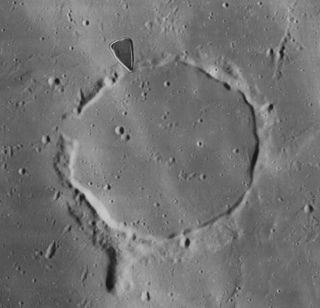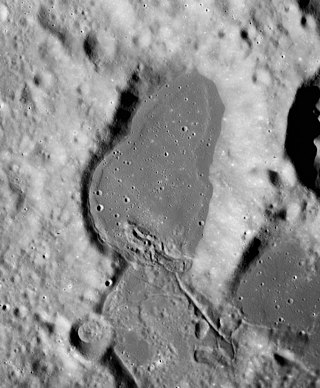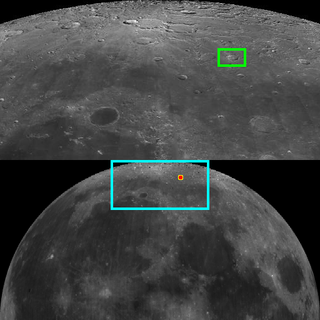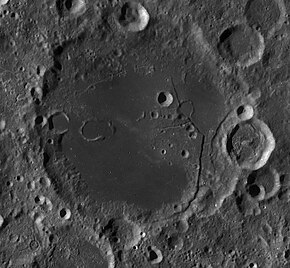
Archimedes is a large lunar impact crater on the eastern edges of the Mare Imbrium. Its diameter is 81 km.

Beaumont is a lava-flooded crater located on the southwestern shore of the Mare Nectaris on Earth's Moon. It lies to the northwest of the similarly flooded crater remnant Fracastorius. To the west is the prominent crater Catharina. The crater is named after French geologist Léonce Élie de Beaumont.

Fracastorius is the lava-flooded remnant of an ancient lunar impact crater located at the southern edge of Mare Nectaris. To the northwest of this formation lies the crater Beaumont, while to the northeast is Rosse.

Kane is the walled remains of a lunar impact crater that has been flooded by lava from Mare Frigoris to the south, and it lies on the northeast edge of this mare. The crater lies midway between the craters C. Mayer to the west and Democritus in the east. To the north-northeast is the crater Moigno.

Kies is the remnant of a lunar impact crater that has been flooded by basaltic lava, leaving only a remnant of the outer rim. It was named after German mathematician and astronomer Johann Kies. It is located in the Mare Nubium almost due south of the crater Bullialdus. Northwest of Kies is König. To the south-southwest lies a lunar dome structure designated Kies Pi (π). It has a small crater at the top and is most likely volcanic in origin.

Doppelmayer is the remains of a lunar impact crater that lies on the southwest edge of Mare Humorum. It was named after the German mathematician and astronomer Johann Gabriel Doppelmayr. To the south-southeast is another flooded crater designated Lee, and to the southeast is Vitello. Just to the east-northeast of Doppelmayer lies the nearly submerged crater Puiseux.

Thomson is a lunar impact crater that is located within the Mare Ingenii on the far side of the Moon. Just to the northeast is the unusual merged crater formation of Van de Graaff. On the northwest rim of the mare is O'Day, and to the south-southwest is Obruchev on the southern shore of Mare Ingenii.

Joliot is a large lunar impact crater that lies on the far side of the Moon, just past the eastern limb. At this location it lies in a region of the surface that comes into sight during a favorable libration, although at such times it is viewed from the side. Thus viewing this crater in detail must be done from orbit.

Belʹkovich is a large lunar impact crater of the form termed a walled plain. The formation has been heavily eroded by a history of subsequent impacts, leaving it reshaped, worn, and the features softened and rounded. Belʹkovich is located along the northeastern limb of the Moon, and so its visibility is subject to libration effects. From the Earth this crater is viewed from the side, making it difficult to view it in detail.

Bowditch is a lunar impact crater that lies on the far side of the Moon, just beyond the eastern limb. It is located on a region of the lunar surface that is brought into view due to libration, but at such times the area is viewed from the edge and so not much detail can be observed. It lies just to the north of the small Lacus Solitudinis lunar mare, between the craters Titius to the southwest and Perel'man to the east-northeast.

C. Mayer is a lunar impact crater that is located at the northern edge of the Mare Frigoris, due north of the prominent crater Aristoteles. Also to the south, but only a third as distant, is the smaller crater Sheepshanks. Due east of C. Mayer is the flooded crater Kane.

Crozier is a lunar impact crater that is located on the southwest edge of Mare Fecunditatis, a lunar mare in the eastern part of the Moon's near side. It lies to the east-northeast of the prominent crater Colombo, and southeast of the small crater Bellot.

Chrétien is a lunar impact crater that is located in the southern hemisphere on the far side of the Moon from the Earth. It lies due south of the Mare Ingenii, one of the few maria on the Moon's far side. The crater lies in the midpoint between the craters Garavito to the west-southwest and Oresme to the east-northeast, both of these being somewhat smaller than Chrétien.

Leibnitz is a huge lunar impact crater that is located in the southern hemisphere on the far side of the Moon. This formation is the same size as Clavius on the near side. It is located to the east-southeast of Mare Ingenii, and is joined to the northeast rim of Von Kármán. Attached to the eastern rim of Leibnitz is Davisson, and intruding into the southeast rim is Finsen. Farther to the west is the large Oppenheimer.

Lamb is a lunar crater that lies beyond the southeastern limb on the Moon's far side. It is located in an irregular lunar mare region named Mare Australe, just to the east of the crater Jenner.

Gum is a lunar impact crater that is located near the southeastern limb of the Moon, and is viewed nearly from the side from Earth. It lies along the western edge of the irregular Mare Australe, to the northeast of the crater Hamilton. To the north-northwest is the larger Abel, and to the east-southeast on the far side of the Moon is Jenner.

Jenner is a lunar crater that is located within the Mare Australe. It lies just past the southeastern limb, on the far side of the Moon, and can be viewed from the Earth during periods of favorable libration and lighting. Nearly attached to the eastern outer rim of Jenner is the larger, flooded crater Lamb.

Pauli is a lunar impact crater that is located on the Moon's far side. It lies about halfway between the lunar equator and southern pole, across the southern rim of the larger walled plain Roche.

Lebedev is a crater on the far side of the Moon. It is named after Russian Physicist Pyotr Lebedev. It is located at the eastern edge of the irregular feature known as Mare Australe. The crater lies to the southeast of the larger, flooded Lamb, and to the east-northeast of Anuchin. To the southeast of Lebedev lies the smaller crater Cassegrain.

Lundmark is an eroded crater on the far side of the Moon. It lies to the southwest of the Mare Ingenii, one of the rare mare areas on the far side. Nearly attached to the southwestern outer rim of Lundmark is the crater Koch, and located to the northwest is the flooded Jules Verne.





















